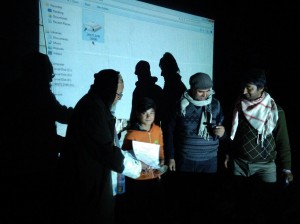Last week, I shared the story of neglect but also of creative aspirations of the children and the
women in Gurej valley. During 40 th shodhyatra, we also came across many more possibilities. It
seems government has belatedly realised a fraud that had been going on in education sector. A lot
of school teachers were initially posted in this region and then using their political clout got
transferred to better endowed regions. Similarly, in the recruitment drive for the services including
para military services, youth from this region could not get the attention they deserved despite their
stronger claims. The medical facilities were also very weak. Even the army medical facility in the
region, which helped civilian population without any hesitation or reservation did not have a
pathological facility. The lab-in- a-suitcase, which Army Medical wing has acquired from BIRAC
supported biotech start-up like Accuster, has not reached here. It can perform 36 tests in one hour
in less than 250 rs. Such facilities must be provided in all border and other less developed regions
urgently. Local youth can be trained to perform these tests.
Majority of the schools did not have a computer lab or science lab. Such labs are needed in these
regions even more. The Mid Day Meal program in nine schools in the region was allocated one
fourth of the ration needed for 220 days (only about 21 quintal of grains were provided). Ministry of
HRD must look into this kind of discrimination urgently. On one hand, there was a general notion
that Kashmir was given a lot of resources and subsidies, and the reality seemed totally contrary to
such an impression, unless the resources meant for this region were pilfered or pre-empted on the
way. Earlier, we had noticed similar neglect in skill development program.
A young class six student Khursheed Ahmedabd Meer, Niru village told very excitedly, ”do u know
that when an electronic gadget goes out of order, not all components of it go wrong?, I feigned
ignorance. I asked, so what should one do if such is the case. He said, “ we should have one room in
every village where such things should be deposited. Children can take out the functional
components and make new things by using them”. “ have you made any such thing?” I asked. Of
course, he replied and rushed to his home to bring a fan that he had made by salvaging a motor
from a broken gadget. I hope colleagues in Atal Innovation Mission and Niti Aayog are listening and
will sanction a tinkering lab in this village. The Honey Bee Network through Prof Bhat of Kashmir
University, Electronics deptt, has already initiated steps to start a small community innovation lab.
When children come out with innovations in not just products and services but also the structure of
governance, the future of our country is quite bright.
How can we rethink developmental opportunities in the region: a) every developmental policy
should be first implemented in marginal regions and after saturating the needs there, less privileged
regions should be covered. It will require change in the fundamental priorities of the developmental
planning and implementation. May be 100 most economically backwards districts and within them,
the most backwards blocks and villages should be prioritized first; b) the huge drudgery that women
go through must make them the top priority for LPG gas provision, also their other problems may
get urgent attention such as skills, tools and weaving designs, and child care; c) the education
standards among children with even limited teachers they had was impressive, may be more
support by recruiting teachers for the block and district only can address the chronic problem of
transfers; d) while there was no malnutrition, still mid day meal scheme and other such program
need to be strengthened; e) modernization of post-harvest processes, access to improved varieties,
urgent investment in hydro power generation and lift irrigation is needed (NIF is encouraging
grassroots innovators to set up such devices), e) in view of occasional fire engulfing wooden houses
in the villages, fire retardant/resistant technologies must be urgently introduced; f) landslide due to
glacial movement is a perpetual problems. Deforestation is making it worse, stabilization of the hill
slopes needs a massive program for safety and wellbeing of local communities and also our forces in
the region.
A team of Honey Bee Network has already left fr Gurez valley to share spinning wheel, winower, and
numerous other needs that could be met through local innovations and resources supported by
SRISTI and NIF besides many volunteers. Hope that policy planners will start rethinking
developmental design in such regions, critical for national integrity and wellbeing.
